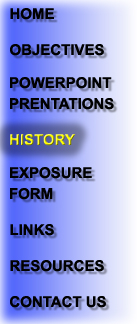Medical Component
of the Occupational History

Introduction and Patient
Demographics
The physician should identify
themselves and their role.
The patient’s age, gender and marital status should be
recorded.
Chief Complaint
Identify the major problems and
establish the reason for the visit. Get the patient to
describe in their own words why they have sought medical
attention.
History of the Presenting
Illness
Explore the important symptoms:
determine their onset, duration and time course; establish
location, quality, quantity, setting, aggravating and
alleviating factors, associated manifestations and the effect of
therapy.
Explore their feelings about the
illness; their ideas about the current problem (do they think it
is related to work or another activity?); how it is impacting
their daily functioning (are they worried about performing at
work or home?) and their expectations from the visit.
Medication History
Current and past medications, over
the counter medications, vitamins and supplements need to be
asked about and recorded. Ask also about any drug allergies –
find out which drug and note the reaction when it is taken.
Habits
Including dietary patterns,sleep
patterns, exercise, use of caffeine, tobacco, alcohol,and
non-prescription drugs.
|
gg |
Systems Review
Screening questions are asked
to search for problems in other body
systems.
Past Medical History
A review of past medical and surgical
illness, which has not been previously covered, should be
included. Any conditions that a patient may have been previously
diagnosed with that may predispose them towards having one
particular disease versus another should be specifically
inquired about.
Family History
The ages, states of health or cause
of death of mother, father, siblings, spouse and children and
any hereditary illnesses that run in the family should be
inquired about.
Current Life Situation
Explore the family system and living
situation. Any emotional stresses at work or economic pressures
could be contributing to the development of a work-related
disease. Household chores and hobbies should also be discussed
and the movements involved in tasks and any exposures clarified
if necessary.
References
1.Year 2 Clinical Methods Handbook.
1999. Faculty of Medicine and Dentistry, University of Western
Ontario. London, Ontario.
|

